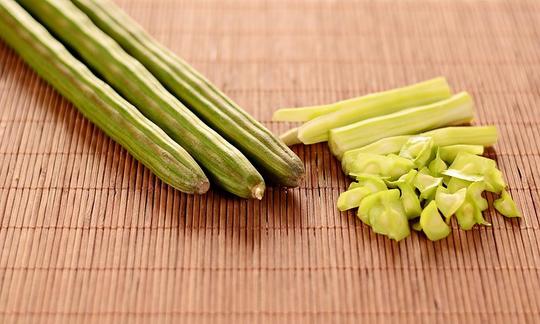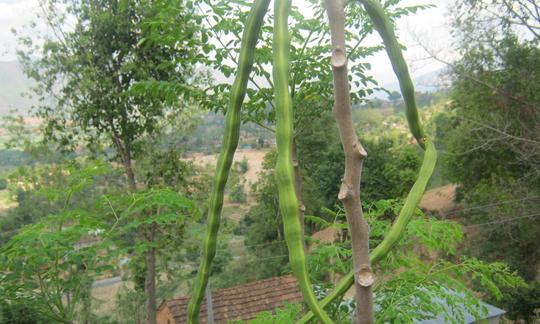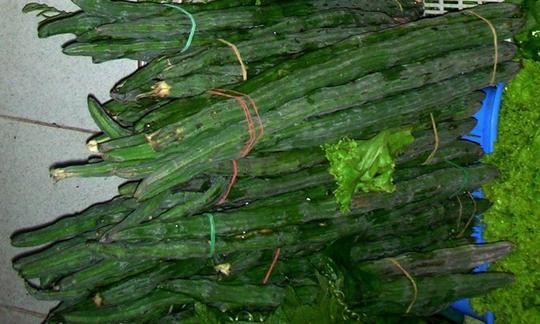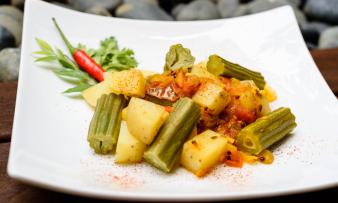Table of contents
The horseradish tree ( Moringa oleifera) is known as the miracle tree (like other plants) because of its nutrient-rich plant parts. Raw horseradish tree pods are usually cooked before consumption.
Using Moringa pods in the kitchen:
The young, unripe seed pods ( moringa pods) are the fruits of the horseradish tree and are also known as 'drumsticks' (drumstick vegetables). They are not horseradish (see "General information" below).
How can you prepare horseradish tree pods? Horseradish tree pods can be cut into short pieces when raw and then cooked (for soups, curries or as so-called drumsticks) or pickled. 18 The outer skin remains tough and fibrous even after cooking. That is why the pod is discarded after intensive chewing or the pulp and seeds are sucked out of the moringa pods. The taste of the moringa pods is reminiscent of asparagus or green beans, but is a little sweeter and occasionally has a slightly bitter note. Very young and tender moringa pods can also be eaten raw, but there is little further information on this topic. 19
The leaves, flowers and sprouts are also eaten as cooked vegetables or raw. Ripe seeds are roasted and eaten like nuts, unripe seeds are prepared like peas or eaten raw. 18 When seasoning Moringa dishes, the natural salt content of the plant must be taken into account. You can find more information in our articles Horseradish tree (Moringa), leaf, raw and Horseradish tree (Moringa), leaf, cooked.
The turnip-like roots are used to make a horseradish substitute or dried as a seasoning. The roots contain benzyl mustard oil, which is responsible for the horseradish-like taste (hence the name horseradish tree). Before using the roots, the slightly poisonous, alkaloid-containing bark must be removed. 18
Vegan recipe for spice soup with horseradish tree pods:
Ingredients (for four people): 1 tamarind, soaked in water for 15 minutes; 1 teaspoon cumin seeds ; 1 teaspoon blackpeppercorns ; 3 raw garlic cloves, peeled; 4 raw tomatoes, finely diced; 1 teaspoon garam masala ; half a teaspoon turmeric powder ; 2 tablespoons HOLL rapeseed oil; 1 teaspoon mustard seeds ; 1 pinch chili flakes ; 1 teaspoon curry leaves, dried; 2 raw horseradish tree pods (drumsticks, organic), in thick slices; 1 liter drinking water ; salt to taste; 1 tablespoon raw coriander leaves, finely chopped.
Preparation: The flesh of the soaked tamarind can be separated from the stone with a knife. This is then processed into a paste in a small high-performance blender together with cumin, pepper and garlic. The paste is then mixed with the diced tomatoes, the garam masala and the turmeric powder.
Heat the oil in a pan and sauté the mustard seeds, chili, curry leaves and the horseradish tree pods (moringa pods) until the mustard seeds burst. Then pour in about a litre of drinking water and add the tomato spice paste. Let the spice soup with drumsticks simmer for about 30-45 minutes, season with salt to taste and garnish with fresh coriander leaves.
It goes well with steamed rice, vegetable curry or Indian flatbread.
Vegan recipes with horseradish tree pods can be found under the note: " Recipes that have the most of this ingredient ".
| Not only vegans or vegetarians should read this: Vegans often eat unhealthily. Avoidable nutritional errors. |
Shopping - where to buy horseradish tree pods?
Raw moringa pods can be bought in Indian delicatessens, Asian shops or online (usually available as drumsticks, moringa drumsticks or drumstick pods). Dried moringa leaf greens can be bought in supermarkets such as Rewe, Spar, Alnatura, Denns or at Coop vitality. We have not yet found any products with moringa (raw, frozen or even organic) in supermarket chains such as Migros, Aldi, Lidl, Edeka, Denner, Volg or Hofer.
In addition to chia seeds, acai berries and other foods, manufacturers advertise Moringa as a "superfood". According to the European Union 's Health Claims Regulation, health-related claims are only permitted if there is scientific evidence for the health-promoting effects. Since this is lacking to the required extent for Moringa oleifera, manufacturers are not allowed to advertise Moringa as a superfood. Moringa products are registered as food supplements and therefore have the same status as "normal" foods. 1,2
If you buy moringa powder or moringa leaves as a substitute for raw drumsticks, prefer certified organic quality. Investigations by the Chemical Veterinary and Investigation Office ( CVUA) in Stuttgart show pesticide residues, salmonella contamination or labeling deficiencies in some moringa products without the organic designation. 3,4
Found in the wild - Horseradish tree pod season:
The horseradish tree is a deciduous tree with a pale grey, copper-coloured and sometimes bottle-like thickened trunk. It branches out into many far-protruding, thinner and somewhat hanging branches. The roots are turnip-like thickened. The 30-60 cm long leaves are pinnate. The individual leaflets are oval and approx. 1-2 cm long. The fragrant flowers with their five petals are cream-coloured and have a diameter of approx. 2.5 cm. The flowers can appear in panicles up to 15 cm long. The hanging, approx. 2 cm wide, ribbed capsules reach a length of 25-50 (sometimes 90) cm. They are bean-like, initially green and later brown. Inside are the seeds, which are up to 1.5 cm in size, round or almost triangular and each have three papery wings. 5
Season: Leaves, flowers, unripe fruits and ripe seeds can be harvested at any time and used fresh. 5 The young, green horseradish tree pods are often harvested about 40 days after flowering, as a woody shell develops during the ripening process.
Storing horseradish tree pods:
Raw, fresh moringa products have a shorter shelf life than dried extracts or capsules. Fresh twigs and moringa leaves can be kept in a vase of water for a few days. Raw horseradish tree pods (moringa pods) can be stored in the refrigerator for a few days wrapped in a damp tea towel. Once cut and blanched, the drumsticks can be frozen in convenient portions.
Moringa ingredients - nutritional values - calories:
Raw horseradish tree pods or moringa pods are low in calories (37 kcal/100g) and rich in vitamin C with 141 mg/100g. It must be noted that losses occur during cooking. Other foods rich in vitamin C are garlic mustard (261 mg/100g), guavas (228 mg/100g), sweet peppers (184 mg/100g) or black currants (181 mg/100g). 6.7
Moringa oleifera contains varying amounts of flavonoids (quercetin, kaempferol or kaempferol, isorhamnetin). 9 The moringa plant also contains carotenoids, saponins and plant zeatin (plant hormone). 1
While raw horseradish tree pods contain 2.1 g of protein per 100 g, the fresh leaves contain 7-10% protein. 5,6,7
Mustard oil glycosides are responsible for the horseradish taste of the turnip-like roots. When the moringa roots are processed, the pungent benzyl mustard oil is developed. The outer layer of the moringa roots contains toxic alkaloids.
False promises:
Sales websites like to advertise Moringa with an alleged vitamin B12 content. Plant-based foods can contain traces of real cobalamins if there has been contamination with bacteria or fermentation. The formation of measurable vitamin B12 would therefore occur via microorganisms and not via the Moringa plant itself. Since there are strong fluctuations here, these foods are not considered reliable sources of vitamin B 12. They could also possibly be structurally related analogues that do not have any vitamin effectiveness. To date, there is little information on the effectiveness and safety of vitamin B12 analogues that are formed through nutrient interactions in vitamin and mineral supplements. 6,7,21,22
Why is Moringa so healthy? CVUA studies confirm that Moringa oleifera contains a wide range of nutrients. At the same time, the results show that the plant does not contain above-average levels of any individual nutrients. 4
The complete ingredients of the horseradish tree pods, the coverage of the daily requirement and comparison values with other ingredients can be found in our nutrient tables in CLICK FOR below the ingredients picture.
Health aspects - effects:
Is Moringa really that good? The scientific data for the actual effectiveness of Moringa preparations on human health is poor. Results from basic research and animal studies cannot be transferred one-to-one to humans. 1,8
What is Moringa good for? In the tropics, immune-boosting effects on locals have been observed. In Africa, for example, patients with a less balanced diet benefit from Moringa oleifera. In order to be able to assess the effects on people in western cultures, the production and use of standardized extracts is desirable. 9
How does Moringa affect the body? Scientific reviews on the anti-cancer effect of Moringa oleifera demonstrate the anti-tumor potential of the plant. Antioxidants contained in it inhibited cancer cells in cell cultures and thus led to cell death (apoptosis). The animal experiments and in vitro studies with cancer cell lines listed in the two reviews (2018) showed effective inhibition of breast cancer, colon cancer, skin cancer, pancreatic cancer, liver cancer, ovarian cancer and altered lung cells as well as a liver-protective effect. Since studies with humans are still lacking, Moringa oleifera does not yet have any significance in the treatment of cancer. 1,10,11
A scientific review from August 2020 shows possible approaches to treating elevated blood sugar and blood lipid levels. Before Moringa oleifera can be used medically for this purpose, prior risk assessments are necessary. 12,13
Dangers - intolerances - side effects:
Can Moringa be harmful? Possible warnings do not refer to the pods, but to Moringa products made from the roots and leaves of Moringa oleifera : They contain mustard oil glycosides. In very large quantities they are toxic, which is why the content limits consumption. 4.20 High doses of leaf extracts (> 3000 mg/kg body weight) led to genetic damage in animal experiments (2012). Ingestion of a maximum of 1000 mg/kg body weight was safe for the test rats. 1.16
If Moringa oleifera capsules are taken at the same time as medication (immunomodulators, anti-hormone therapy), interactions may occur. In cancer patients, ingredients in Moringa can inhibit the liver's cytochrome P450 enzyme type 3A4. In these cases, use should be discussed with the treating doctor. 14
Folk medicine - naturopathy:
In the local, traditional medicine of India, Sri Lanka, Java and Africa, all parts of the horseradish tree are used.
Young moringa leaves are used in traditional medicine to stimulate milk flow, the root juice for inflammatory diseases and the bark or resin for blood poisoning. Other traditional uses for internal treatment include tuberculosis, asthma, gout, rheumatism, enlarged spleen or liver, gallstones and kidney stones. Externally, the seeds, bark, roots and resin are used for boils, ulcers, swollen glands, infected wounds, skin diseases, tooth infections, snake bites and gout. 5
Occurrence - Origin - Ecology:
The horseradish tree with its long pods originally comes from the Himalayan region in northwest India. The tree is now found in almost all tropical and subtropical regions. 9
Growing in the garden or as a potted plant:
Is Moringa hardy? In temperate regions, Moringa thrives as a potted plant in the room or winter garden. In summer, the tree can be kept frost-free on the terrace or balcony at minimum temperatures of 15-18 °C. 5,12
Cultivation - Harvesting Horseradish Tree Pods:
Moringa oleifera is the most commonly cultivated species of the Moringa genus. The main areas where the horseradish tree is grown include South India, Thailand, the Philippines, Honduras and South America. With an annual production of 1.1-1.3 million tons of fruit from an area of 380 m 2, India is the largest producer of Moringa products. 15
As a fast-growing and nutrient-rich plant , Moringa oleifera is used to combat malnutrition in developing countries. In addition, its cultivation can support local, regional and international agriculture. 8
Ecological aspects:
Moringa oleifera is used to harsh conditions and requires little water. Moringa species are therefore used to reforest the Sudanese Sahel zone. 9 Cultivation in Honduras is intended to counteract deforestation.
Danger of confusion:
Moringa oleifera is colloquially known as the 'miracle tree'. It shares this name with other plants. This can lead to confusion due to ambiguous names, e.g. with castor oil plant.
The castor oil plant or castor bean ( Ricinus communis) is a poisonous plant from the family of the wolfsbane family. This plant species originally comes from northeast Africa and the Middle East. Today the tree is widespread in all tropical zones. In tropical climates, the (real) castor oil plant can reach heights of over 10 m after several years. It forms a woody trunk. The 30 to 70 cm large leaves are palmately split. The racemose and paniculate inflorescences are 30-40 cm long. The fruits resemble chestnuts, but have softer spines.
For the botanical properties of Moringa oleifera, read above under "Found in the wild".
General information about Moringa pods:
The horseradish tree ( Moringa oleifera, syn.: Guilandina moringa) belongs to the Moringaceae family. The plant is not related to horseradish ( Armoracia rusticana).
The drumstick plant is a tree with pods. The pod is the fruit of the plant (also called drumstick/drumsticks or drumstick pods). The Moringa leaves can be eaten raw (organic if possible), the nutrient-rich Moringa pods and the Moringa seeds are usually enjoyed cooked, but they can also be eaten raw.
Alternative names:
Important alternative names for the horseradish tree ( Moringa oleifera) are miracle tree, behen tree, behen nut tree, clarifying agent tree, drumstick tree or horseradish tree. The horseradish tree pods are called moringa pods, drumsticks, drumstick, murungaikai, munakkayi or nunge kai.
In English, the moringa tree is called a drumstick tree or horseradish-tree (also: ben oil tree, benzolive tree or reseda) and the horseradish tree pods (moringa pods) are called drumsticks or drumstick pods or moringa drumsticks or moringa drumstick pods.
Keywords for use:
In African countries, the moringa leaves and unripe horseradish tree seeds are used as animal feed during the dry season. 9 The behen oil (ben oil) or moringa oil produced from the ripe seeds is used as cooking oil and in the cosmetics industry. The ancient Egyptians knew it as a skin care product and anointing cone in the context of funeral and religious scenes. 17
The German Federal Environmental Foundation was able to show that horseradish tree seeds are suitable for the treatment of drinking water. In developing countries, this property can be of great benefit. 1
Literature - Sources:
Bibliography - 20 Sources
| 1. | Krebsinformationsdienst.de Moringa. ‚Wunderbaum‘ zur Krebstherapie? |
| 2. | Eur-lex.europa.eu Verordnung (EG) Nr. 1924/2006 des Europäischen Parlaments und des Rates vom 20. Dezember 2006 über nährwert- und gesundheitsbezogene Angaben über Lebensmittel. PDF. |
| 3. | Ua-bw.de Perchlorat in pflanzlichen Lebensmitteln. Ein Follow-up. |
| 4. | Ua-bw.de Nicht besonders super. Das ‘Super Food’ Moringa. |
| 5. | Bown D. Kräuter. Die grosse Enzyklopädie. Anbau und Verwendung. München: Dorling Kindersly; 2. Auflage. 2015. |
| 6. | USDA (United States Department of Agriculture). Nährstofftabellen. |
| 7. | Diet-health.info Nährstofftabellen. |
| 8. | Medizin-transparent.at Moringa: Wunderbaum zum Einnehmen? |
| 9. | Deutsche-apotheker-zeitung.de Unterschiede in Gehalt und Zusammensetzung der Flavonoide in Moringa-Arten. |
| 10. | Bhattacharya A, Tiwari P et al. A review of the phytochemical and pharmacological characteristics of moringa oleifera. J Pharm Bioallied Sci. 2018;10(4):181-191. |
| 11. | Kou X, Li B et al. Nutraceutical or pharmacological potential of moringa oleifera lam. Nutrients. 2018;10(3). |
| 12. | Ugb.de Wie super sind Superfoods? |
| 13. | Meireles D, Gomes J et al. A review of properties, nutritional and pharmaceutical applications of Moringa oleifera: integrative approach on conventional and traditional Asian medicine. Advances in Traditional Medicine. Published online August 17, 2020:1-21. |
| 14. | Klartext-nahrungsergaenzung.de Moringa. |
| 15. | Krankenkassenzentrale.de Moringa. Wirkung der Moringa oleifera Pflanze. |
| 17. | Stevens A, Rogge CE et al. From representation to reality: ancient Egyptian wax head cones from Amarna. Antiquity. Dezember 2019;93(372):1515–33. |
| 18. | Fs.fed.us Moringa oleifera Lam. July 1993. PDF. |
| 19. | fao.org Food and Agriculture Organization of the United Nations. Traditional Crops. Moringa. |
| 21. | Elmadfa I, Leitzmann C. Ernährung des Menschen. Stuttgart: Eugen Ulmer-Verlag; 4. 2004. |
| 22. | Englert H, Siebert S. Vegane Ernährung (Hrsg.). Bern: Haupt Verlag; 1. Auflage. 2016. |













Comments